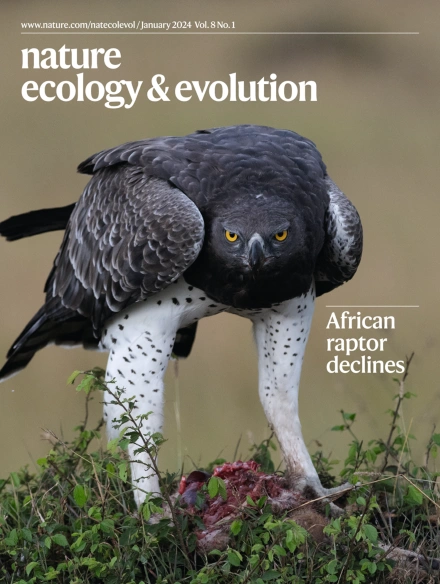Vibrio pectenicida strain FHCF-3 is a causative agent of sea star wasting disease
IF 13.9
1区 生物学
Q1 ECOLOGY
引用次数: 0
Abstract
More than 10 years following the onset of the sea star wasting disease (SSWD) epidemic, affecting over 20 asteroid species from Mexico to Alaska, the causative agent has been elusive. SSWD killed billions of the most susceptible species, sunflower sea stars (Pycnopodia helianthoides), initiating a trophic cascade involving unchecked urchin population growth and the widespread loss of kelp forests. Identifying the causative agent underpins the development of recovery strategies. Here we induced disease and subsequent mortality in exposure experiments using tissue extracts, coelomic fluid and effluent water from wasting sunflower sea stars, with no mortality in controls. Deep sequencing of diseased sea star coelomic fluid samples from experiments and field outbreaks revealed a dominant proportion of reads assigned to the bacterium Vibrio pectenicida. Fulfilling Koch’s postulates, V. pectenicida strain FHCF-3, cultured from the coelomic fluid of a diseased sunflower sea star, caused disease and mortality in exposed sunflower sea stars, demonstrating that it is a causative agent of SSWD. This discovery will enable recovery efforts for sea stars and the ecosystems affected by their decline by facilitating culture-based experimental research and broad-scale screening for pathogen presence and abundance in the laboratory and field. The causative agent of sea star wasting disease has been elusive. This study used genetic datasets and experimental exposures to demonstrate that a strain of the bacterium Vibrio pectenicida caused disease and mortality in sea stars.

pectenicida弧菌FHCF-3菌株是海星消瘦病的病原体。
海星萎蔫病(SSWD)的流行影响了从墨西哥到阿拉斯加的20多个小行星物种,10多年来,致病因子一直难以捉摸。ssd杀死了数十亿个最易受影响的物种——向日葵海星(Pycnopodia helianthoides),引发了一个营养级联,包括不受控制的海胆数量增长和海带森林的广泛消失。确定致病因子是制定恢复策略的基础。在这里,我们在暴露实验中使用组织提取物、体腔液和消耗向日葵海星的废水诱导疾病和随后的死亡,对照组没有死亡。对实验和野外爆发的患病海星体腔液样本的深度测序显示,绝大部分的reads被分配给了pectenicida弧菌。从患病向日葵海星体腔液中培养出的V. pectenicida菌株FHCF-3符合Koch的假设,在暴露的向日葵海星中引起疾病和死亡,证明它是SSWD的病原体。这一发现将促进基于培养的实验研究以及在实验室和野外对病原体的存在和丰度进行大规模筛选,从而使海星和受其衰退影响的生态系统的恢复工作成为可能。
本文章由计算机程序翻译,如有差异,请以英文原文为准。
求助全文
约1分钟内获得全文
求助全文
来源期刊

Nature ecology & evolution
Agricultural and Biological Sciences-Ecology, Evolution, Behavior and Systematics
CiteScore
22.20
自引率
2.40%
发文量
282
期刊介绍:
Nature Ecology & Evolution is interested in the full spectrum of ecological and evolutionary biology, encompassing approaches at the molecular, organismal, population, community and ecosystem levels, as well as relevant parts of the social sciences. Nature Ecology & Evolution provides a place where all researchers and policymakers interested in all aspects of life's diversity can come together to learn about the most accomplished and significant advances in the field and to discuss topical issues. An online-only monthly journal, our broad scope ensures that the research published reaches the widest possible audience of scientists.
 求助内容:
求助内容: 应助结果提醒方式:
应助结果提醒方式:


